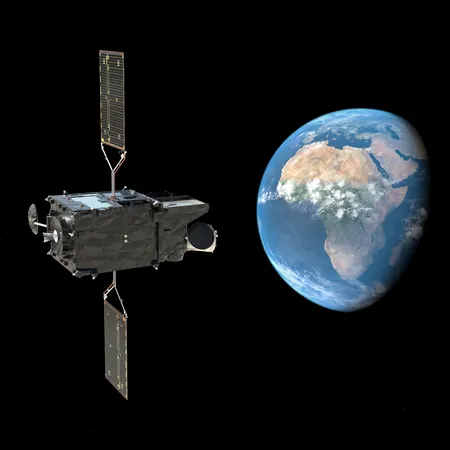
Revolutionizing Air Quality Monitoring: Meet Sentinel-4!
2025-06-05
Author: Michael
Imagine a satellite high above Earth, keeping a watchful eye on the air we breathe. The Copernicus Sentinel-4 mission, stationed over 36,000 km into space, is set to transform air quality monitoring across Europe and parts of northern Africa. This groundbreaking mission provides hourly updates on major pollutants, paving the way for unprecedented air quality forecasting.
Why Geostationary Orbit Matters
Sentinel-4 is the first of its kind to monitor European air quality from geostationary orbit—a position that allows it to continuously observe the same area, much like a hawk surveying its territory. This strategic placement enables the satellite to scan and relay real-time data from Europe and northern Africa every hour, a feat not achievable by traditional low-Earth orbit satellites.
According to Ben Veihelmann, ESA's Sentinel-4 Mission Scientist, "This is a complete game changer for forecasting air quality." Rapidly changing pollution levels caused by traffic, industrial operations, and atmospheric conditions can now be tracked in real-time, offering insights that were previously unavailable.
Innovative Collaboration for a Common Goal
Unlike its predecessors, Sentinel-4’s instrument is integrated into the Meteosat Third Generation Sounder satellite, combining air quality monitoring with meteorological functions. This two-in-one approach not only optimizes resources but also enhances the efficiency of both missions.
"By embedding a specialized air quality instrument within a broader weather satellite, we’re maximizing infrastructure and increasing operational capacity," observes Mission Manager Giorgio Bagnasco.
Global Cooperation Against Air Pollution
As part of a global effort, Sentinel-4 joins American and Korean sensors to form a comprehensive monitoring network. This constellation of geostationary air quality sensors spans continents and showcases international collaboration, proving that pollution knows no borders. Together, they provide critical data that help track air quality across densely populated regions in the northern hemisphere.
Making an Impact with Data
What’s even more remarkable is that Sentinel-4’s data will be freely and openly accessible. From air quality service providers to researchers, a diverse group of users will leverage this data for monitoring pollution levels, issuing health warnings, and complying with air quality regulations.
Veilhelmann highlights its profound impact: "Sentinel-4 isn’t just about monitoring; it’s about improving lives. Its insights will inform air quality forecasts, pollution alerts, and health advisories, particularly for vulnerable populations like asthma sufferers. This mission will support environmental policies and public health initiatives, ultimately strengthening our response to climate change."
How It Works
The Sentinel-4/UVN spectrometer captures sunlight reflecting off Earth’s surface and atmosphere. As this light passes through the atmosphere, pollutants leave detectable signatures, allowing the satellite to estimate levels of various trace gases, including nitrogen dioxide and ozone. This technology doesn’t just track pollution; it also provides crucial information about its vertical distribution, aiding in the development of effective mitigation strategies.
In summary, the Sentinel-4 mission represents a monumental leap forward in air quality monitoring, promising not just to inform, but to protect and enhance the health of millions.









 Brasil (PT)
Brasil (PT)
 Canada (EN)
Canada (EN)
 Chile (ES)
Chile (ES)
 Česko (CS)
Česko (CS)
 대한민국 (KO)
대한민국 (KO)
 España (ES)
España (ES)
 France (FR)
France (FR)
 Hong Kong (EN)
Hong Kong (EN)
 Italia (IT)
Italia (IT)
 日本 (JA)
日本 (JA)
 Magyarország (HU)
Magyarország (HU)
 Norge (NO)
Norge (NO)
 Polska (PL)
Polska (PL)
 Schweiz (DE)
Schweiz (DE)
 Singapore (EN)
Singapore (EN)
 Sverige (SV)
Sverige (SV)
 Suomi (FI)
Suomi (FI)
 Türkiye (TR)
Türkiye (TR)
 الإمارات العربية المتحدة (AR)
الإمارات العربية المتحدة (AR)